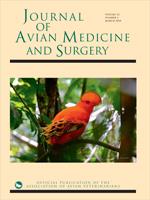With increased ownership of backyard poultry, veterinarians must treat these birds appropriately and take into consideration drug withdrawal times for eggs meant for consumption. Few studies have examined the pharmacokinetics or egg residues for medications commonly used in avian medicine. This study determined the pharmacokinetics of meloxicam in domestic chickens (n = 8) after oral dosing at 1 mg/kg q12h for a total of 9 doses (5 days). Additionally, the presence of meloxicam residues in eggs was determined. The terminal half-life, maximum concentration, and time to maximum concentration were 3.02 ± 1.15 hours, 7.14 ± 1.54 μg/mL, and 1.6 ± 0.52 hours, respectively. No drug was detected in yolks and whites after 8 days and 3 days, respectively. On the basis of these results, a 2-week withdrawal time should be adequate to avoid drug residues in eggs meant for consumption.
How to translate text using browser tools
1 March 2018
Pharmacokinetics and Egg Residues of Meloxicam After Multiple Day Oral Dosing in Domestic Chickens
Marcy J. Souza,
Joan Bailey,
Molly White,
Kristen Gordon,
Lillian Gerhardt,
Sherry K. Cox
ACCESS THE FULL ARTICLE





